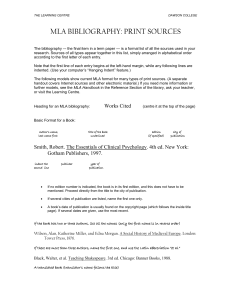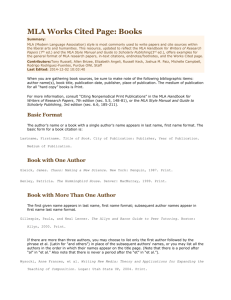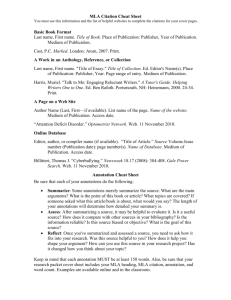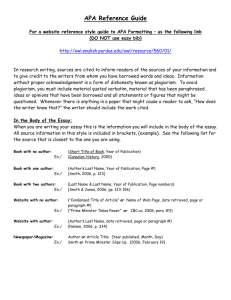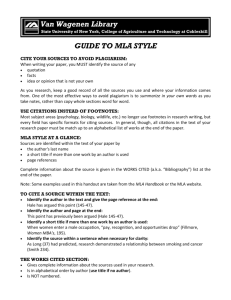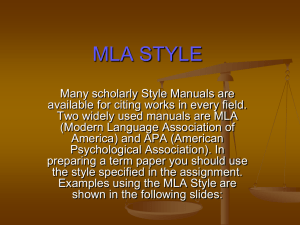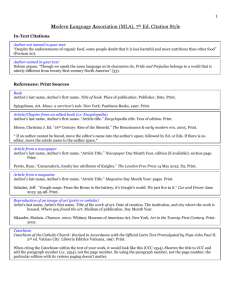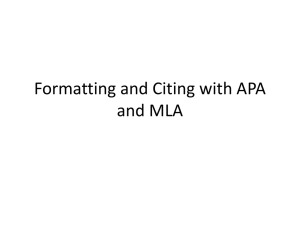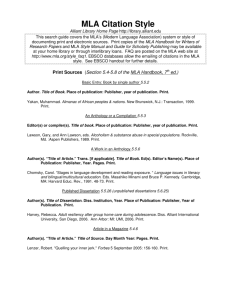MLA BIBLIOGRAPHY: PRINT SOURCES
advertisement
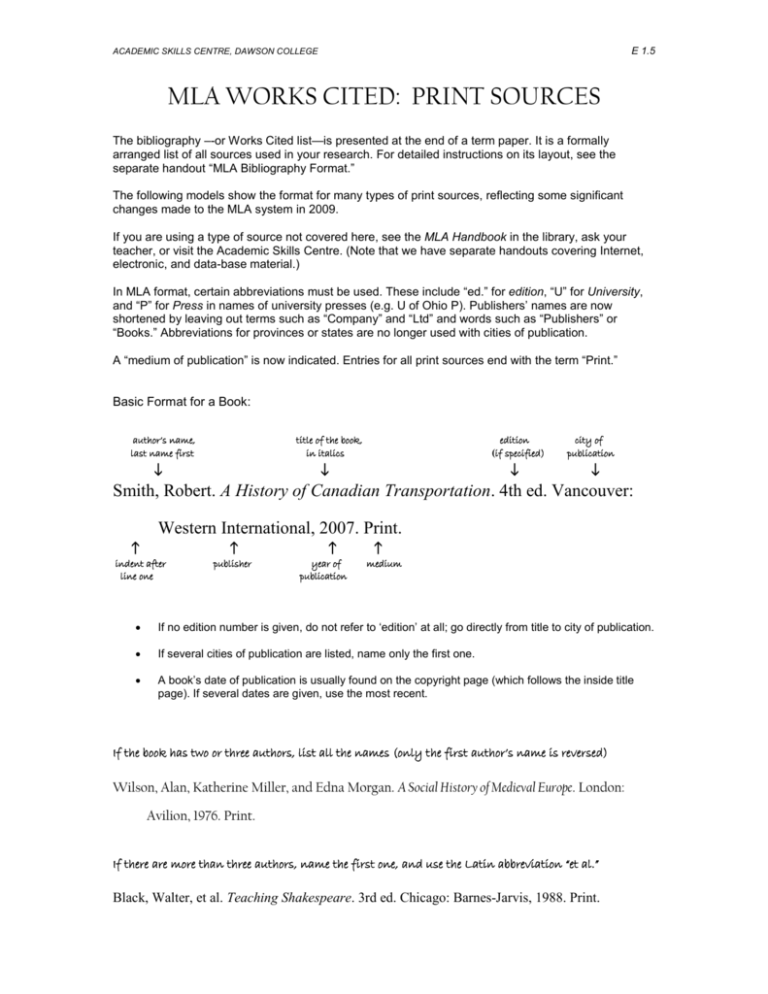
E 1.5 ACADEMIC SKILLS CENTRE, DAWSON COLLEGE MLA WORKS CITED: PRINT SOURCES The bibliography –-or Works Cited list—is presented at the end of a term paper. It is a formally arranged list of all sources used in your research. For detailed instructions on its layout, see the separate handout “MLA Bibliography Format.” The following models show the format for many types of print sources, reflecting some significant changes made to the MLA system in 2009. If you are using a type of source not covered here, see the MLA Handbook in the library, ask your teacher, or visit the Academic Skills Centre. (Note that we have separate handouts covering Internet, electronic, and data-base material.) In MLA format, certain abbreviations must be used. These include “ed.” for edition, “U” for University, and “P” for Press in names of university presses (e.g. U of Ohio P). Publishers’ names are now shortened by leaving out terms such as “Company” and “Ltd” and words such as “Publishers” or “Books.” Abbreviations for provinces or states are no longer used with cities of publication. A “medium of publication” is now indicated. Entries for all print sources end with the term “Print.” Basic Format for a Book: author’s name, last name first title of the book, in italics edition (if specified) city of publication Smith, Robert. A History of Canadian Transportation. 4th ed. Vancouver: Western International, 2007. Print. indent after line one publisher year of publication medium If no edition number is given, do not refer to ‘edition’ at all; go directly from title to city of publication. If several cities of publication are listed, name only the first one. A book’s date of publication is usually found on the copyright page (which follows the inside title page). If several dates are given, use the most recent. If the book has two or three authors, list all the names (only the first author’s name is reversed) Wilson, Alan, Katherine Miller, and Edna Morgan. A Social History of Medieval Europe. London: Avilion, 1976. Print. If there are more than three authors, name the first one, and use the Latin abbreviation “et al.” Black, Walter, et al. Teaching Shakespeare. 3rd ed. Chicago: Barnes-Jarvis, 1988. Print. An essay in a book of essays (author of the essay is named first; editor’s name follows the book title with “Ed.”; entry ends with page numbers of the entire essay, then medium of publication) Porter, Ellen B. “The Bureaucratic Elite.” Essays on Canadian Politics. Ed. Timothy Barnes. Toronto: Macmillan, 1991. 56-59. Print. A poem or short story in an anthology (as above, entry includes the page numbers of the entire item) Chopin, Kate. “The Story of an Hour.” America’s Short Fiction. Ed. Grace G. Millar. Chicago: Midwestern, 1978. 121-125. Print. Magazine article: If published weekly , give the full date; if published monthly, give the month only (include the page numbers of the entire article, but if pages are not continuous, give the first page with a plus sign, e.g. 12+) Baker, Mary G. “Real Estate Goes Bust.” Newsweek 6 Feb. 2009: 14-15. Print. Cooper, Eric. “Springtime in Patagonia.” National Geographic Oct. 1997: 46-51. Print. Scholarly journal article (give volume number then issue number, separated by a period; then the year, in parentheses; then the page numbers of the entire article and medium of publication) Woodridge, Frank. “The Private Company.” Business Law Quarterly 56.3 (1990): 317-331. Print. Newspaper article (omit “The” at the beginning of a newspaper’s name; if the name does not include the city, add it in square brackets; full date of publication is given; newspaper pages often include a letter indicating the section; give the page numbers of the entire article, but if the pages are not continuous, give the first page with a plus sign, e.g. B1+) Fisk, Roberta. “Threats of Global Warming.” Gazette [Montreal] 17 Jan. 2008: D12-13. Print. Pamphlet (treated like a book; if no author is named, begin with the title) Reducing Workplace Cancer Risks. Washington: American Cancer Society, 2001. Print. Encyclopedia article (if the article’s author is named, open with that name; if no author is named, open with the article’s heading in quotation marks; edition may be indicated by a number or by a year) Tucker, David G. “India.” Encyclopedia Americana. 15th ed. Print. “Magnetism.” Collier’s Encyclopedia. 1990 ed. Print. Source: MLA Handbook, 7th ed. (2009) WM 2009
